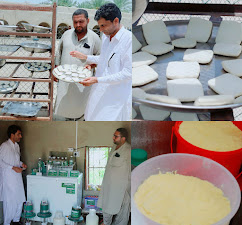The Future Impact
of Climate Change on Crop Production in Balochistan: Challenges and Strategic
Solutions
Yahya Musakhel, Business Development Manager, Pakistan Poverty
Alleviation Fund
Balochistan, Pakistan's largest province, faces an array of interrelated
and unresolved challenges in the water and agriculture sectors. Climate change,
coupled with population growth, water mismanagement, and unsustainable
agricultural practices, has made the situation increasingly precarious. With a
fragile agricultural ecosystem and a rising demand for water, the province is
at a critical juncture, requiring immediate and integrated reforms to ensure
sustainable food and water security.
Water Crisis and Governance Challenges
Water scarcity in Balochistan is not a recent phenomenon but a result of decades of mismanagement and overexploitation. The traditional water management systems such as Karezes, khushkaba, and sailaba—once vital for irrigation and livestock needs—have been disrupted by over-reliance on tube wells and unregulated water extraction. The introduction of diesel and electric-powered tube wells in the 1970s and 1980s led to the indiscriminate pumping of groundwater, which, combined with subsidies and fixed electricity tariffs, has severely depleted the water table.
Today, many regions in Balochistan experience critical water
shortages, with groundwater levels dropping to depths of over 1,000 feet in
some areas. The destruction of rangelands and deforestation in catchment
areas have further reduced the water retention capacity of the soil, increasing
the frequency of flash floods and droughts. While the population continues to
grow, the absence of a robust water governance framework exacerbates the
crisis.
Climate Change and Agricultural Vulnerability
Balochistan's agricultural sector, which supports a significant portion
of its population, is highly sensitive to climate variability. Rising
temperatures, shifting rainfall patterns, and prolonged droughts have severely
impacted crop productivity and livestock.
A recent study leveraging downscaled climate projections
(CORDEX-CORE) and the FAO eco-physiological model (PyAEZ) assessed
the effects of climate change on ten key crops, including grapes, olives,
dates, apples, wheat, and maize. The findings reveal alarming trends:
- Decline in
Crop Yields: Increasing
temperatures and erratic rainfall reduce the yields of water-intensive
crops such as apples, wheat, and rice.
- Destruction
of Orchards: Long periods
of drought have led to the desiccation of 2 million acres of orchards,
particularly those growing exotic apple and cherry varieties introduced
during the 1970s.
- Loss of
Livestock: Balochistan
has lost three-fourths of its livestock population during severe droughts,
such as the ones from 1996–2003.
- Shift to
Indigenous Crops: Farmers
are beginning to revert to more drought-tolerant indigenous species such
as olives, pistachios, and almonds, though these efforts remain limited.
Key Historical Trends in Water Management and Agriculture
Before 1966
- Water
extraction was balanced between recharge and discharge.
- Sustainable
agricultural practices and collective management of Karezes ensured water
availability.
- Livestock
formed the backbone of rural economies.
Post-1966
- The
introduction of diesel-powered tube wells led to farmland expansion and
cultivation of water-intensive crops.
- By the 1970s,
subsidized electricity further encouraged over-extraction of groundwater,
causing a sharp decline in the water table.
- Traditional
institutions governing water resources weakened, replaced by profit-driven
individualism.
1980s–2000s
- Afghan
refugee influx and population growth increased pressure on natural
resources.
- Deforestation
for fuel and overgrazing degraded catchment areas, reducing soil water
retention capacity.
- Repeated
droughts, such as the devastating 1996–2003 drought, led to large-scale
migration, loss of farmland, and significant livestock mortality.
2003 Onwards
- Despite
efforts to build delay-action dams and promote water harvesting, drought
mitigation remains inadequately integrated into government planning.
- Flash floods
continue to destroy livelihoods, while droughts persist in arid regions.
Strategic Solutions and Reforms
- Integrated
Water Governance
Water governance must become a top priority in
Balochistan's development agenda. This includes:
- Establishing
provincial water management authorities.
- Implementing
equitable water distribution policies.
- Educating
policymakers and consumers on efficient water use.
- Reviving
Traditional Practices
Revitalizing Karezes and promoting
indigenous water management systems like khushkaba and sailaba
can provide sustainable solutions for irrigation and recharge of groundwater.
- Promoting
Climate-Resilient Agriculture
- Shift focus
to drought-resistant indigenous crops such as pistachios, almonds, and
pomegranates.
- High efficiency
Irrigation and technology insertion and value addition
- Introduce
heat-tolerant wheat and maize varieties.
- Provide
financial incentives for adopting sustainable farming practices like
GRASP project initiatives and Access to finance from Fis.
- Investing
in Technology and Infrastructure
- Build more
delay-action dams to enhance surface water storage.
- Develop
modern irrigation systems such as drip and sprinkler irrigation to reduce
water wastage.
- Encourage
research and development in climate-smart agriculture through
collaborations with international organizations.
- Reforestation
and Rangeland Rehabilitation
- Launch
afforestation campaigns to restore forests in catchment areas.
- Regulate
grazing practices to prevent overexploitation of rangelands.
- Disaster
Preparedness and Mitigation
- Develop
robust drought and flood preparedness strategies.
- Ensure
timely relief and rehabilitation programs for affected communities.
The Way Forward
Balochistan's water and agricultural crises are inherently interconnected, requiring a strategic and integrated approach. Water reforms, effective governance, and investment in sustainable agriculture are critical to mitigating the impact of climate change. Policymakers, farmers, and institutions must work collaboratively to ensure food security, protect livelihoods, and secure water resources for future generations.
With climate smart investments and advancements in technology, Balochistan has the potential to emerge as a model for sustainable water and agricultural management in arid regions. However, the time to act is now—delays in addressing these challenges will only deepen the province's vulnerability to climate change and water scarcity.
.jpeg)










No comments:
Post a Comment